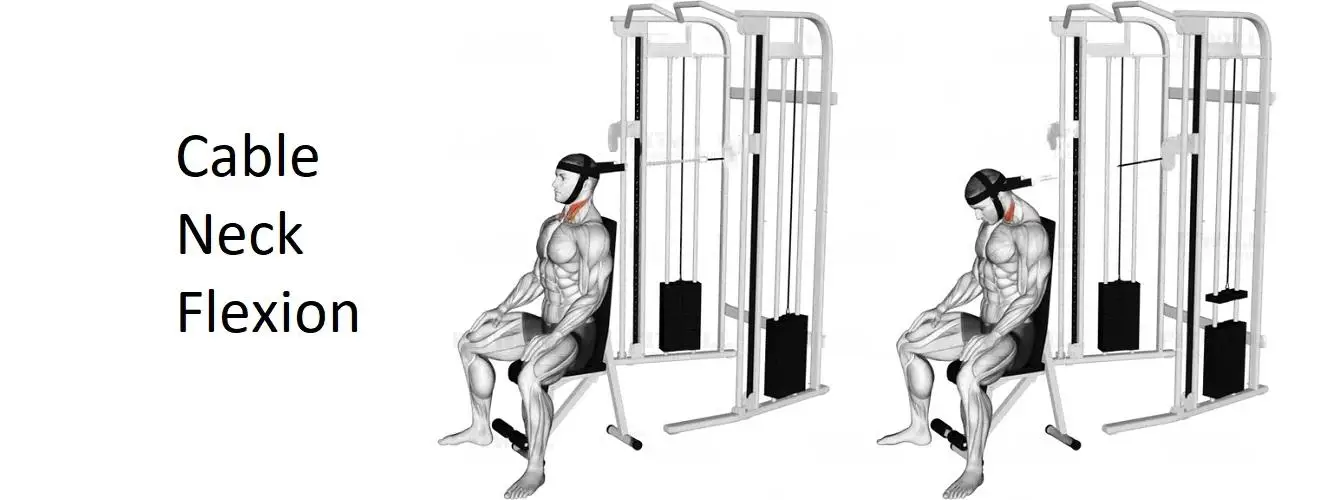Cable Neck Flexion is an exercise designed to strengthen the muscles of the neck, particularly the anterior neck muscles, including the sternocleidomastoid and anterior scalene muscles. This exercise involves flexing the neck against resistance provided by a cable machine. In this comprehensive guide, we’ll explore the correct technique, benefits, variations, and other essential details associated with Cable Neck Flexion.
Instructions
Setup:
- Adjust the Cable Machine: Attach a handle or rope attachment to the lowest setting on a cable machine. Ensure that the weight stack is set at an appropriate resistance level.
- Position Yourself: Stand facing away from the cable machine, with your feet shoulder-width apart and knees slightly bent. Hold the handle or rope attachment with both hands, palms facing down.
Execution:
- Starting Position: Stand tall with your spine in a neutral position and your shoulders relaxed. Keep your arms fully extended and your hands positioned at hip level.
- Neck Flexion: Inhale and slowly lower your chin towards your chest, flexing your neck forward against the resistance of the cable. Maintain a slow and controlled movement throughout the exercise.
- Peak Contraction: Once you reach a comfortable point of flexion, pause for a brief moment to squeeze the muscles at the front of your neck. Focus on engaging the sternocleidomastoid and anterior scalene muscles.
- Return to Starting Position: Exhale as you slowly release the tension in your neck muscles and return to the starting position, allowing your head to come back to a neutral position.
- Repeat: Perform the desired number of repetitions with proper form and control, aiming for a full range of motion and avoiding any jerky movements.
Tips:
- Start with light resistance and gradually increase the weight as you become more comfortable with the exercise.
- Keep your movements slow and controlled to maximize muscle engagement and minimize the risk of injury.
- Avoid rounding your shoulders or arching your back during the exercise. Maintain good posture throughout.
Benefits
- Neck Strength: Cable Neck Flexion helps strengthen the muscles at the front of the neck, including the sternocleidomastoid and anterior scalene muscles, which are important for maintaining proper head posture and stability.
- Improved Posture: Strengthening the neck muscles can help improve overall posture by supporting the weight of the head and reducing strain on the upper back and shoulders.
- Injury Prevention: Strong neck muscles can help reduce the risk of neck injuries, especially during activities that involve sudden movements or impacts.
- Functional Strength: Cable Neck Flexion targets muscles that are involved in everyday activities such as looking down, lifting objects, and bending forward, making it a functional exercise for daily life.
Muscles worked in Cable Neck Flexion
Cable Neck Flexion primarily targets the muscles of the anterior neck, specifically the sternocleidomastoid and anterior scalene muscles. These muscles play a significant role in flexing the neck forward and tilting the head downward. Additionally, other muscles of the neck, including the platysma and longus colli muscles, may also be engaged to a lesser extent during this exercise.
Here’s an overview of the main muscles worked during Cable Neck Flexion:
- Sternocleidomastoid: The sternocleidomastoid (SCM) is a large muscle located on each side of the neck. It originates from the sternum and clavicle and inserts into the mastoid process of the temporal bone. Contraction of the SCM muscle causes neck flexion and rotation to the opposite side.
- Anterior Scalene: The anterior scalene is a small muscle located on the side of the neck. It originates from the transverse processes of the cervical vertebrae and inserts into the first rib. Contraction of the anterior scalene assists in neck flexion and lateral flexion of the neck.
- Platysma: The platysma is a thin, broad muscle that covers the front of the neck. It originates from the fascia of the chest and shoulders and inserts into the lower jaw and corners of the mouth. Contraction of the platysma helps depress the jaw and lower lip, as well as tense the skin of the neck.
- Longus Colli: The longus colli is a deep muscle located on the front of the neck. It consists of three parts: superior, inferior, and vertical. Contraction of the longus colli muscles helps flex the neck forward and stabilize the cervical spine during movement.
Overall, Cable Neck Flexion effectively targets these muscles, helping to strengthen and tone the anterior neck muscles, improve neck stability, and enhance overall neck health and function. It is important to perform this exercise with proper form and control to minimize the risk of injury and maximize the benefits.
Alternate names for Cable Neck Flexion:
- Cable Neck Curl
- Neck Flexion Exercise
- Cable Neck Extension
- Neck Curl with Cable
Variations
- Single-Arm Cable Neck Flexion: Perform the exercise with one arm at a time to isolate and strengthen each side of the neck individually.
- Seated Cable Neck Flexion: Sit on a bench or chair facing the cable machine to perform the exercise in a seated position, which may provide additional stability and support.
- Cable Neck Extension: Instead of flexing the neck forward, extend the neck backward against the resistance of the cable to target the muscles at the back of the neck.
Conclusion
Cable Neck Flexion is a valuable exercise for strengthening the muscles of the neck and improving overall neck health and function. By incorporating this exercise into your regular workout routine and focusing on proper form and technique, you can effectively build strength and stability in the neck muscles.
Also, check the Dumbbell Alternating Front Raise








